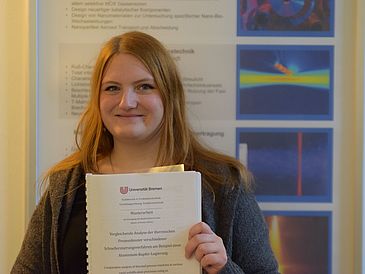After her bachelor's degree in industrial engineering, Malin Kähnlein decided to add a master's degree in production engineering and process engineering. She likes versatility, and refers the term not only to her studies, but also to the alloy she dealt with in her master's thesis: "Comparative analysis of the thermal process windows of different rapid solidification processes using the example of an aluminium-copper alloy", is the title of her thesis.
The solidification of a molten metal determines the structural properties of the material that is later produced. Nowadays, ultra-fine microstructures can be produced by using rapid solidification processes. "The faster the cooling, the finer the microstructure," Malin explains in conversation. Well-known examples are the production of metal powders and particles by atomization processes or single drop generators. Since Malin Kähnlein had attended a lecture with Nils Ellendt during her studies, she knew that there was a single drop generator of this type in subproject U01. Here she carried out some of her experiments and cooled her AlCu droplets by a targeted drop impact. For this purpose, she chose short drop distances so that the droplets collide with a copper plate at only low speed and thus take on the shape of a hemisphere. This impact mode is new compared to "Splat quenching", in which the drop is partially splattered and has a very flat, irregular and jagged shape after impact.
Another rapid solidification process for the production of near-net-shape components is additive manufacturing using SLM (selective laser melting). However, finding and optimizing new alloys for this process is particularly complex at the current state of the art, as the complex interaction between powder properties, alloy and process control must be taken into account. Here Malin has used a laser to melt and solidify conventionally produced particles from an atomization process and particles about ten times the size from a single drop generator on a substrate using the SLM process, and compared the resulting microstructures. Here, she has determined process windows in order to determine processability properties that can be transferred to the powder on the particles from the single-drop process, which are much easier to produce.
Part of her results can now be used in research to develop a new high-throughput process for evaluating new alloys for additive production. With this work, first steps in this direction could be taken for an alloy. The publication of the work in a peer-reviewed journal is already being planned, which makes Malin rightly a little proud.

![[Translate to English:] Zur Startseite des SFB Farbige Zustände](/fileadmin/user_upload/sites/sfb1232/Logos_und_Bilder/SFB1232-quer.png)
